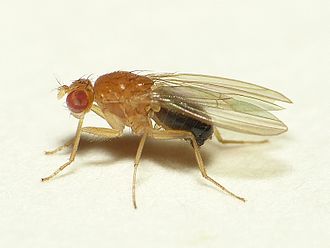Drosophilidae

The Drosophilidae are a diverse, cosmopolitan family of flies, which includes fruit flies. Another unrelated family of flies, Tephritidae, also includes species known as “small fruit flies”. The best known species of the Drosophilidae is Drosophila melanogaster, within the genus Drosophila, and this species is used extensively for studies concerning genetics, development, physiology, ecology and behaviour. This fruit fly is mostly composed of post-mitotic cells, has a very short lifespan, and shows gradual aging. As in other species, temperature influences the life history of the animal. Several genes have been identified that can be manipulated to extend the lifespan of these insects. Additionally, Drosophila subobscura, also within the genus Drosophila, has been reputed as a model organism for evolutionary-biological studies.[1]
Generally, drosophilids are considered to be nuisance flies rather than pests, since most species breed in rotting material. Zaprionus indianus Gupta is unusual among Drosophilidae species in being a serious, primary pest of at least one commercial fruit, figs in Brazil.[2] Another species, Drosophila suzukii, infests thin-skinned fruit such as raspberries and cherries and can be a serious agricultural pest.[3] Drosophila repleta larvae inhabit drains and spread bacteria. Fruit flies in general are considered as a common vector in propagating acetic acid bacteria[4] in nature. This often ruins the alcohol fermentation process and can ruin beer or wine by turning it into vinegar. There are sinking traps available on the market for this nuisance, but one quick way to strongly limit the extent of it is to vacuum clean the flies both at rest and in their slow flight.
The diagnostic characteristics for Drosophilidae include the presence of an incomplete subcostal vein, two breaks in the costal vein, a small anal cell in the wing, convergent postocellar bristles; and usually three frontal bristles on each side of the head, one directed forward and the other two directed rearward. More extensive identification characteristics can be found in “Drosophila: A Guide to Species Identification and Use” by Therese A. Markow and Patrick O’Grady, (Academic Press, 2005) ISBN 0-12-473052-3 or “Drosophila: A Laboratory Handbook” by M. Ashburner, K. Golic, S. Hawley, (Cold Spring Harbor Laboratory Press, 2005).
Of their many defenses against parasites, when Drosophila melanogaster flies see female larval endoparasitoid wasps, they switch to laying their eggs in alcohol-laden food sources such as rotting fruit. Doing so protects the flies from becoming host to the larvae, as the wasps have a low alcohol tolerance. This oviposition behavior change only occurs upon seeing the female wasp larva and does not take place in the presence of the male wasp larva.[5]
There is evidence to support that pathogens living within certain flies are beneficial to the behavior and survival of the host. One such example of this is in the fly Scaptomyza flava, which carries the pathogen Pseudomonas syringae in exchange for the pathogen damaging the anti-herbivore defenses of main food source for the fly, plants in the family Brassicaceae.[6]
